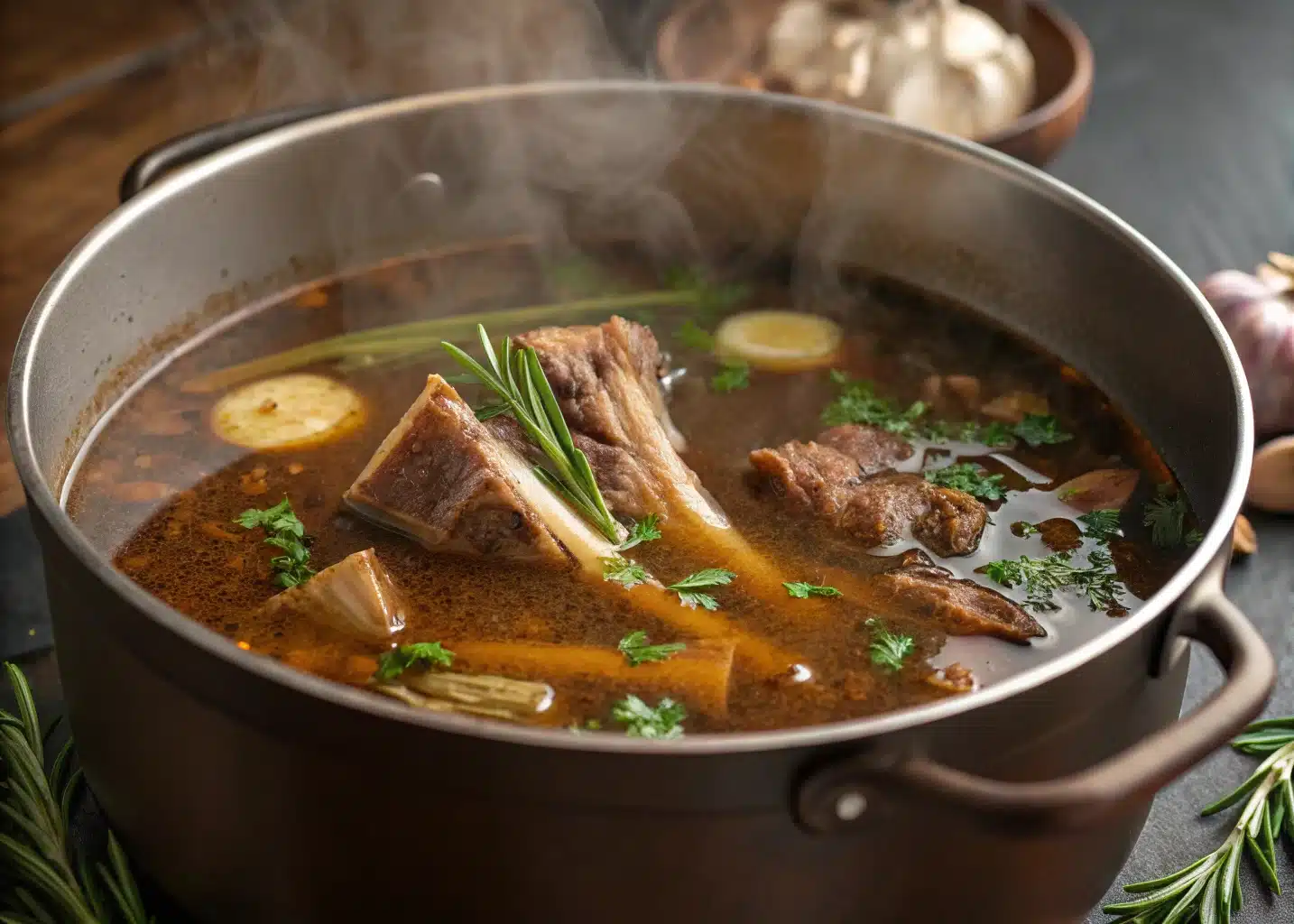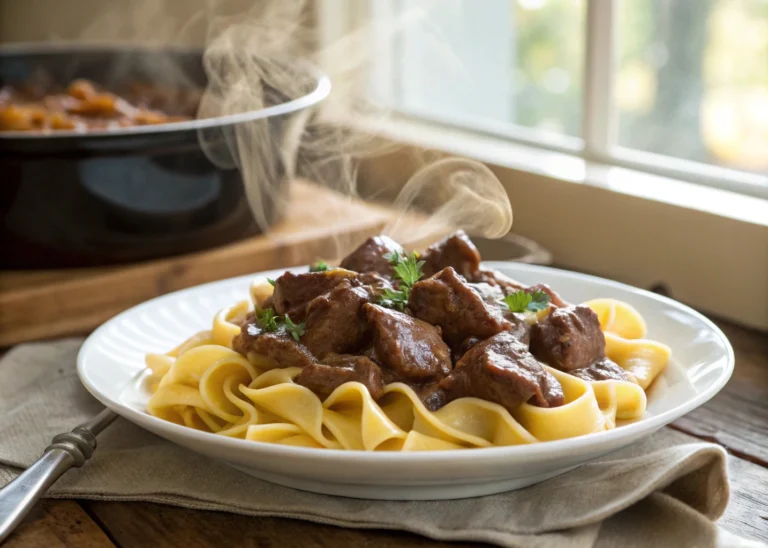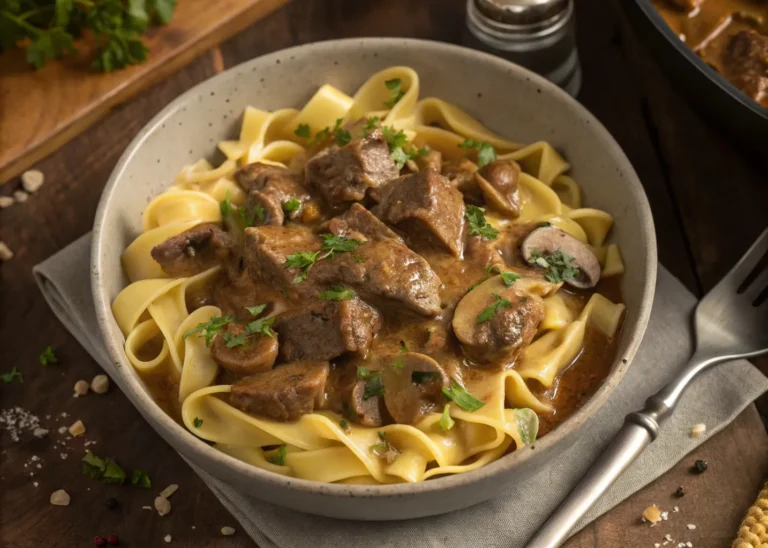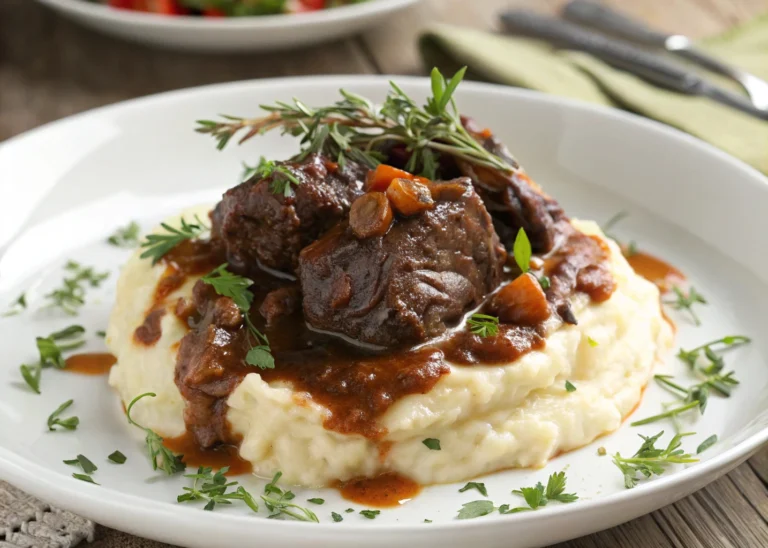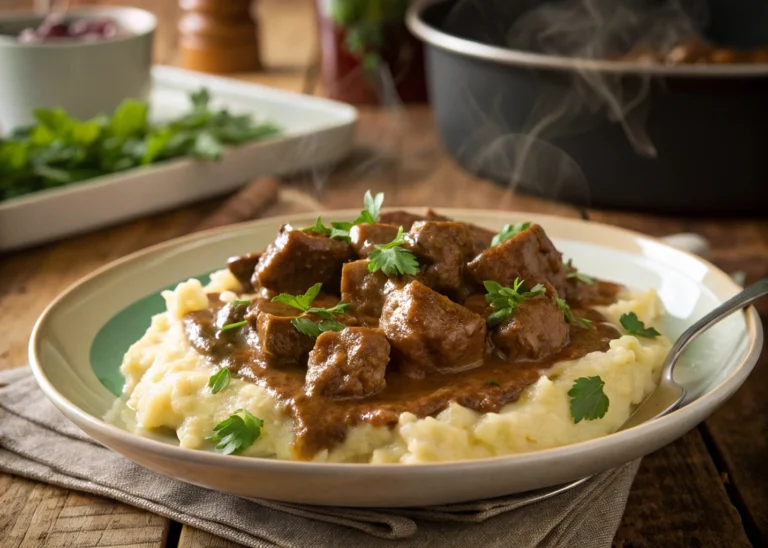Best Beef Bone Broth Recipe
Craving something comforting, wholesome, and packed with nutrients? This beef bone broth recipe is your go-to kitchen hero. Whether you’re sipping it straight, building soups from scratch, or freezing it for future meals, there’s nothing like the deep, slow-cooked flavor of homemade broth. It’s collagen-rich, full of minerals, and way more satisfying than anything off the store shelf. In this guide, we’ll cover exactly how to make it, which bones to use, and the right way to bring out its natural depth and health benefits.
Why Homemade Beef Bone Broth is Better Than Store-Bought
What is beef bone broth?
Beef bone broth is a slow-simmered liquid made by boiling beef bones—like marrow bones, knuckles, and neck bones—along with vegetables, herbs, and an acid such as apple cider vinegar. Simmered for hours (often 12–24), it pulls collagen, gelatin, and nutrients from the bones into a rich, flavorful broth.
Unlike basic beef stock, bone broth is thicker, more gelatinous, and designed to support gut health, skin, joints, and immune function.
Benefits of making it at home vs buying
Homemade bone broth wins every time. While you can buy cartons or jars at the store, most commercial products are thin, lack gelatin, and often include preservatives, fillers, or unnecessary sodium.
Here’s why your own kitchen is the best place to brew it:
| Feature | Store-Bought | Homemade Beef Bone Broth |
|---|---|---|
| Flavor | Flat, salty | Deep, rich, customizable |
| Gelatin content | Low or none | High—jiggles when cold |
| Nutritional profile | Unreliable | Packed with collagen, amino acids |
| Ingredient control | Limited | 100% control over what goes in |
| Cost efficiency | Pricey for small amounts | Makes multiple quarts affordably |
Bottom line? When you make your own, you get better flavor, better nutrition, and far better value.
Ingredients You’ll Need for This Beef Bone Broth Recipe
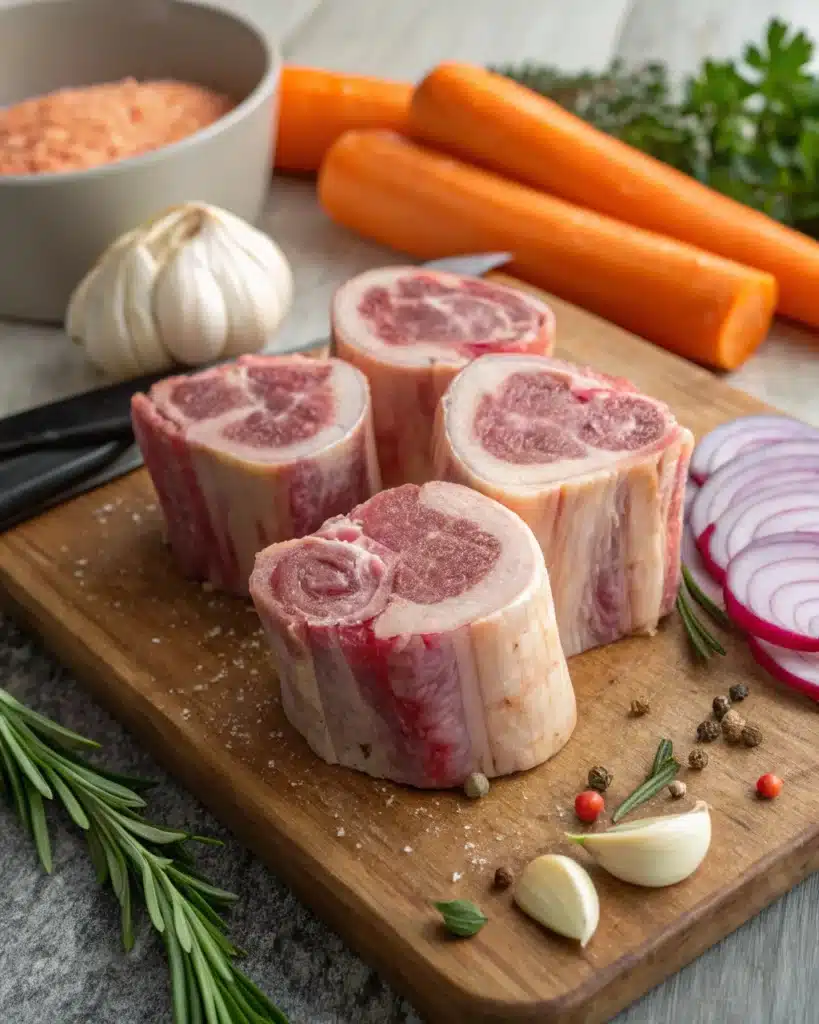
Essential bones and their benefits
The key to a deeply nourishing beef bone broth recipe is variety. Don’t just grab one kind of bone—combine several for optimal flavor and gelatin content.
Here’s your bone breakdown:
- Marrow bones – Adds rich, beefy flavor and healthy fats
- Knuckle bones – Packed with collagen and cartilage
- Oxtail or neck bones – Full of connective tissue for gelatin and taste
- Shank bones – Include some meat, enhancing depth
- Feet or joint bones – Great for thickening with natural gelatin
Always choose grass-fed beef bones when possible. They’re higher in anti-inflammatory omega-3s and healthier fats.
Add-ons: Vegetables, herbs, and acids
These extra ingredients build flavor and help extract nutrients:
Vegetables:
- 2 large onions (quartered)
- 2–3 carrots
- 2–3 celery stalks
Herbs & Aromatics:
- 3–5 garlic cloves
- 1–2 bay leaves
- 1 tsp whole peppercorns
- A few sprigs of thyme or parsley
Acid:
- 2 tbsp apple cider vinegar – helps pull minerals from bones
Water:
Enough filtered water to fully submerge the bones and veggies (typically 4–6 quarts).
How to Choose the Right Beef Bones
Types of bones (marrow, knuckle, oxtail, etc.)
Not all bones are created equal—and not all yield the same results in a broth. To make a flavorful, nutrient-packed broth, mix different types:
- Marrow bones (from femur): Add richness and healthy fat
- Knuckle bones: High in collagen, essential for gel
- Oxtail bones: Deep beef flavor and natural thickeners
- Neck bones: Offer a good mix of meat and bone
- Feet/joint bones: High in connective tissue and gelatin
You can even combine beef and veal bones to increase gelatin yield and improve mouthfeel.
Best sources: Grass-fed, local butcher, or grocery store
High-quality bones mean better broth. Here’s where to get them:
- Local butcher shops: Often sell marrow, knuckle, and soup bones in bulk
- Farmers markets: Grass-fed and pasture-raised options are common
- Online meat suppliers: Great for bulk purchases if you can’t source locally
- Grocery stores: Ask the butcher—most carry or can order beef bones
Pro Tip:
Roast extra bones ahead of time and freeze them. That way, you’ll always be ready to start a batch when you want.
The Cooking Process – Step-by-Step Instructions
Roasting bones for depth of flavor
Roasting isn’t optional—it’s how you unlock that deep, roasted flavor in your broth. Skip this step, and your broth may end up bland or one-dimensional.
Here’s how to do it:
- Preheat oven to 425°F
- Spread bones in a single layer on a rimmed baking sheet
- Roast for 30–40 minutes, turning once halfway
- Bones should be golden brown, not blackened (over-roasting ruins flavor)
If you’re using meaty bones like oxtail or shank, roasting also helps caramelize the meat and fat for a richer color and taste.
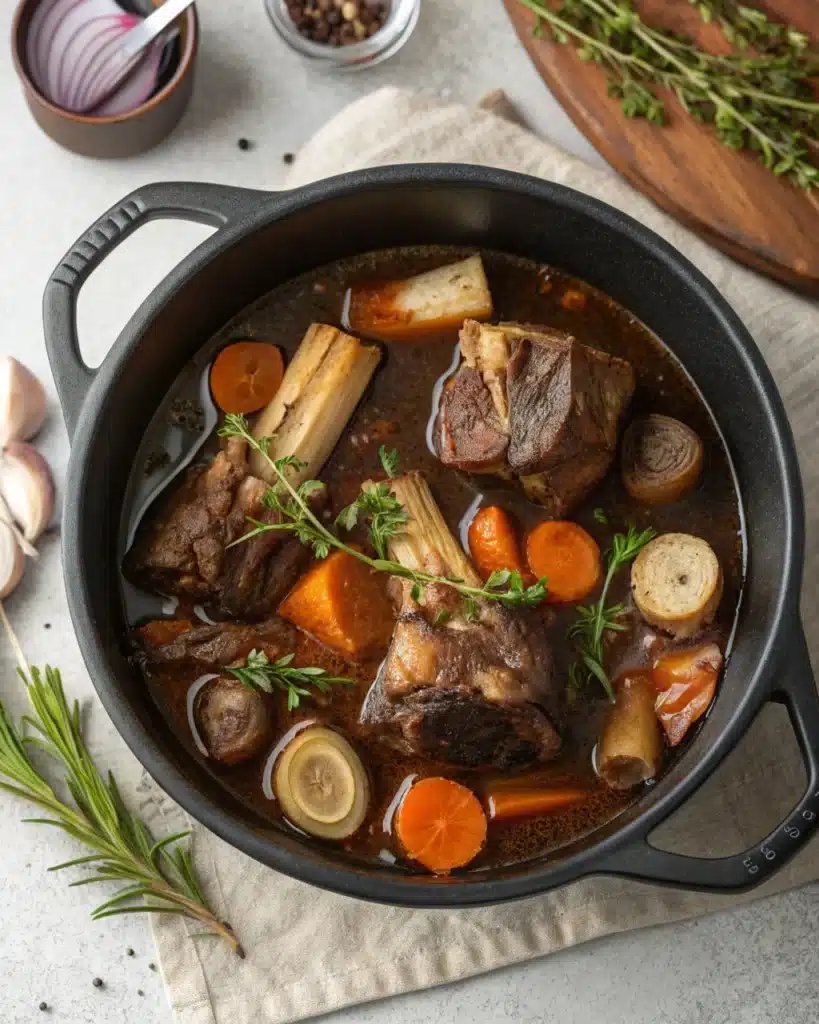
Simmering low and slow: Stove, Instant Pot, or slow cooker
Once roasted, it’s time to simmer—low and slow is key. Here’s a breakdown of the three most effective cooking methods:
| Method | Simmer Time | Pros | Notes |
|---|---|---|---|
| Stovetop | 12–24 hours | Traditional flavor, large batches | Keep heat low to avoid boiling |
| Slow Cooker | 18–24 hours | Hands-off, safe overnight simmering | Great for busy households |
| Instant Pot | 2–3 hours | Fast and powerful | Still great gelatin, less complex taste |
Basic cooking instructions:
- Place roasted bones into a large stockpot or cooker
- Add chopped vegetables, herbs, garlic, vinegar, and cold water
- Bring to a low simmer (never boil—it breaks down gelatin)
- Skim foam and impurities in the first 1–2 hours
- Simmer gently uncovered (or loosely covered)
- Once done, cool slightly before straining
You’ll know it’s ready when the broth is deep brown and the bones look clean and porous.
Skimming, Straining, and Storing Your Broth
When and how to skim foam and fat
Early in the simmering process, you’ll notice a grayish foam rising to the top. This is made of impurities and proteins—removing it leads to a cleaner, more refined broth.
Skimming tips:
- Skim in the first 1–2 hours using a fine-mesh skimmer or spoon
- Don’t stress if you miss some—just avoid stirring it back in
- For excess fat, chill the broth overnight and scoop solid fat off the top
That fat? You can save it as tallow and use it for cooking veggies, frying eggs, or adding to other recipes.
Straining for clarity + proper storage options
Once your broth has simmered long enough:
- Strain the broth using a fine-mesh sieve or layer of cheesecloth to separate out all the bones and vegetables.
- Discard or compost bones and veggies—they’ve done their job
- Let the strained broth cool slightly before transferring to containers
Storage methods:
- Refrigerator: Up to 5 days
- Freezer: Up to 6 months in airtight containers or silicone cubes
- Ice cube trays: For easy use in stir-fries, sauces, or quick sips
Safety tip: Never place hot broth directly into glass jars—cool first to avoid cracking.
Flavor Enhancements and Variations
Adding herbs and spices: garlic, ginger, thyme, etc.
Want to level up your beef bone broth recipe? Strategic herbs and spices can take your broth from basic to brilliant.
Flavor boosters:
- Garlic + onion skins: Add extra depth and immunity support
- Fresh ginger: For a warm, soothing undertone (perfect in winter)
- Thyme + rosemary: Earthy, aromatic—ideal for sipping broths
- Turmeric root or powder: Brightens the color and adds anti-inflammatory benefits
Add herbs in the last few hours of simmering to preserve their flavor.
International twists: Asian, Mediterranean, etc.
Bone broth isn’t just American—it’s universal. Add global flair to your broth with these ideas:
| Region | Additions | Flavor Profile |
|---|---|---|
| Asian | Ginger, scallion, star anise, soy, fish sauce | Umami-rich, bold, healing |
| Mediterranean | Tomato paste, oregano, bay, fennel seeds | Savory, herbal, slightly sweet |
| Latin | Cilantro stems, lime peel, cumin | Bright, zesty, earthy |
Pro move: Simmer a batch plain, then infuse with flavor based on how you’ll use it.
How to Use Beef Bone Broth in Everyday Meals
Soups, stews, sauces, and sipping broth ideas
Once you’ve made a batch of this rich beef bone broth recipe, the possibilities are endless. Here’s how to use it every day:
- Sip it like tea – Pour a warm mugful, season with sea salt, and enjoy it as a gut-friendly drink.
- Soup base – Swap water or boxed stock in your favorite soup recipes for a huge flavor upgrade.
- Stews and braises – Use it for cooking pot roast, short ribs, or brisket. It adds unbelievable depth.
- Sauces and gravies – Simmer bone broth down into rich reductions to pour over meat or veggies.
- Grain cooking liquid – Replace water when cooking rice, quinoa, or barley for boosted nutrition.
- Egg poaching – Add subtle beefy flavor while poaching eggs for breakfast bowls.
Creative ways to use leftover broth
You made a big batch—now use every drop:
- Freeze in silicone trays for sautéing or pan sauces
- Add to mashed potatoes instead of milk for a savory twist
- Blend into smoothies (yes, really) for added protein without sugar
- Use as a base for ramen or pho
The key is batch cooking and freezing. One weekend of simmering gives you weeks of meals.
Nutrition Facts and Health Benefits of Bone Broth
What nutrients are extracted from bones
The slow simmering process extracts a cocktail of nutrients that you won’t find in regular stock or bouillon cubes.
Here’s what your body gets per serving:
- Collagen & Gelatin – Support for joints, skin elasticity, and gut lining
- Amino acids – Glycine, proline, glutamine (great for muscle recovery & digestion)
- Calcium, magnesium, and potassium – Essential for strong bones and maintaining healthy electrolyte levels
- Chondroitin & glucosamine – Natural joint lubricators
- Iron and zinc – Support immune system and oxygen delivery
This isn’t just broth. It’s real, functional food.
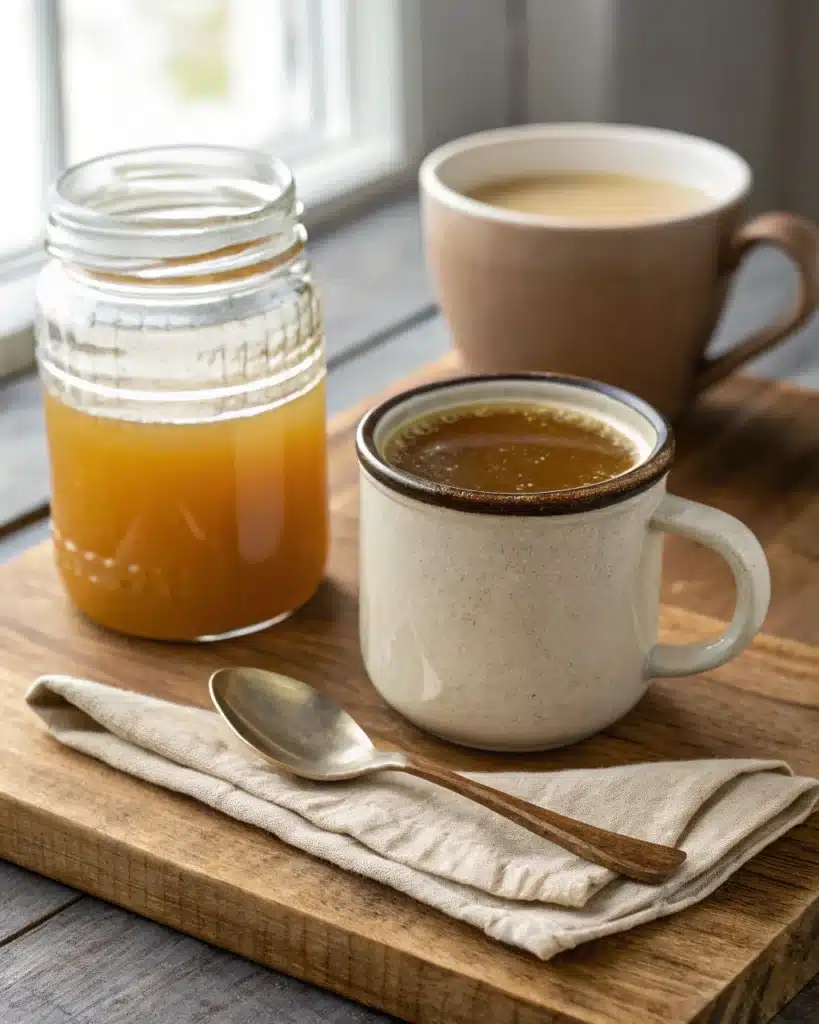
The Gut, Joint, and Skin Benefits of Bone Broth
- Gut health: Gelatin soothes the digestive tract and supports healthy gut lining
- Joint support: Collagen and cartilage work together to strengthen and rebuild connective tissues, improving flexibility and reducing stiffness.
- Skin glow: Collagen improves elasticity and hydration from the inside out
- Better sleep: Glycine can promote calm and deeper sleep
- Immune boost: Zinc and amino acids help your body fight inflammation
This beef bone broth recipe is as much about healing as it is about flavor.
Common Mistakes to Avoid When Making Beef Bone Broth
Boiling vs simmering: Why it matters
Don’t crank the heat. Ever.
- Boiling makes your broth cloudy and bitter
- Simmering gently pulls nutrients slowly and keeps the broth clear
Use the lowest possible heat and give it time. This isn’t fast food—it’s real food.
Why you should avoid seasoning early
Salt draws out moisture—but it also concentrates during long simmers. That means:
- If you salt early, you risk ending up with a broth that’s too salty
- Season after straining, right before serving or freezing
Also avoid:
- Using raw bones without roasting (you’ll lose depth of flavor)
- Leaving the lid on tightly (a loose lid lets steam escape and concentrates flavor)
- Stirring too much (this makes your broth murky)
Avoid these, and your broth will come out crystal-clear and packed with flavor every time.
Frequently Asked Questions (FAQs)
Is beef bone broth good for you?
Absolutely. Beef bone broth is full of collagen, amino acids, and minerals that support gut health, joints, and skin. It’s a natural anti-inflammatory and a great way to add protein without processed ingredients.
How long should you cook beef bone broth?
Simmer for a minimum of 12 hours, but aim for 18–24 hours to extract the most nutrients and flavor. Using an Instant Pot? You’ll get solid results in 2–3 hours, though longer cook times still deliver deeper richness.
Can you reuse bones for a second batch?
Yes—but the second batch will be weaker. Add a few fresh bones or veggies to re-boost flavor and nutrients. Reusing is great for broth cubes or low-sodium recipes.
What’s the difference between beef stock and beef bone broth?
Bone broth simmers longer and uses bones with connective tissue. It’s richer in gelatin and nutrients, while stock is typically faster and thinner.
Can you freeze beef bone broth?
Definitely. Freeze in mason jars (leave headspace), silicone trays, or freezer-safe bags for up to 6 months. Thaw in the fridge overnight or over low heat.
Do I have to roast the bones first?
Yes, if you want deep, rich flavor. Roasting enhances the broth’s color and brings out meaty undertones you simply won’t get from raw bones.
Conclusion: Why This Is the Only Beef Bone Broth Recipe You’ll Ever Need
A good beef bone broth recipe isn’t just food—it’s nourishment. With its robust flavor, silky texture, and deep health benefits, this broth transforms any meal it touches. By using high-quality bones, simmering low and slow, and straining carefully, you’re creating something your body will thank you for.
Looking for inspiration? Try pairing your broth with our Tender Beef Tips and Noodles Crock Pot Recipe for a comforting, protein-packed dinner.
Now go grab your pot—your best batch yet starts today.
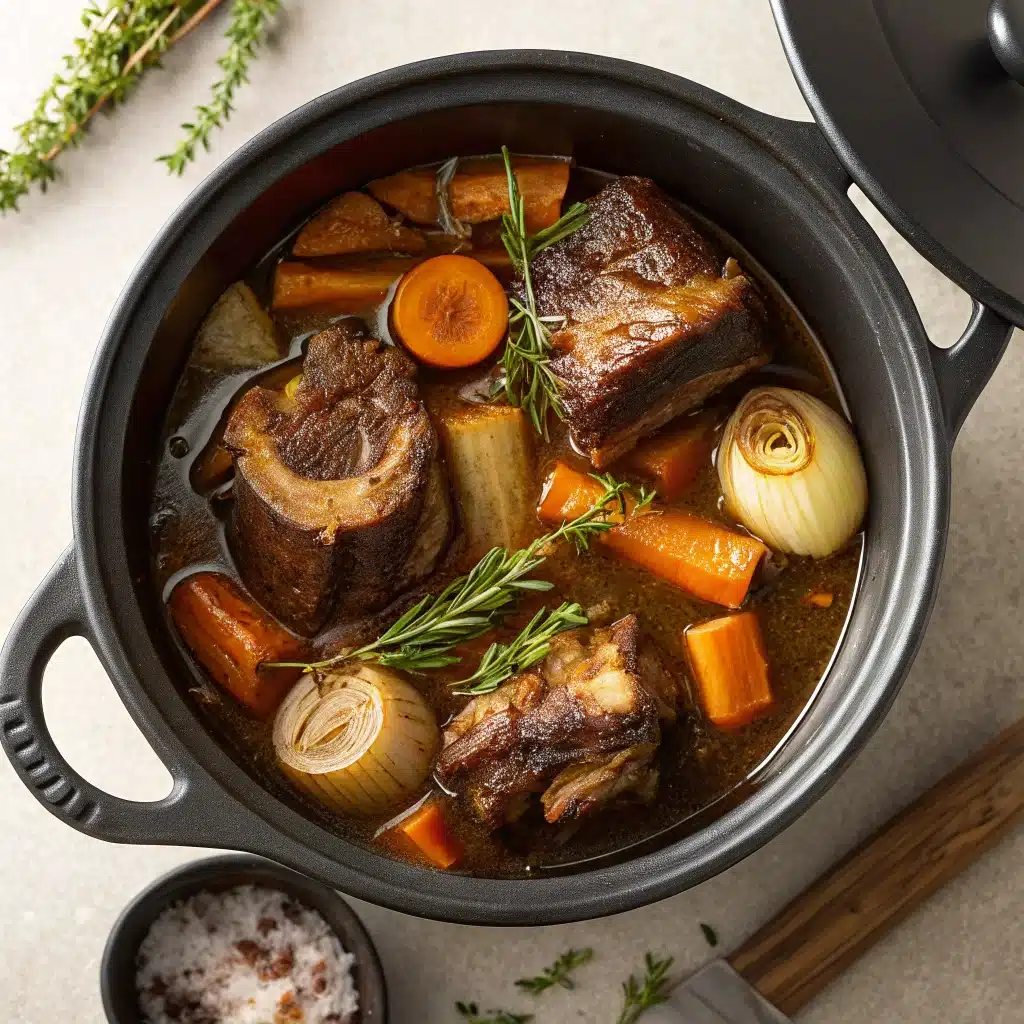
Beef Bone Broth Recipe
Ingredients
Equipment
Method
- Preheat oven to 425°F. Arrange bones on a baking sheet and roast for 30–40 minutes until golden brown.
- Transfer bones to a large pot. Add vegetables, vinegar, herbs, and enough water to fully submerge.
- Bring to a low simmer. Skim foam during the first hour. Continue simmering uncovered for 18–24 hours (or 2–3 hours in Instant Pot).
- Use a fine-mesh strainer or cheesecloth to remove solids. Discard bones and vegetables.
- Let broth cool. Transfer to jars. Refrigerate up to 5 days or freeze up to 6 months.
Notes
- Always roast your bones before simmering. This adds caramelization and richer flavor to your broth.
- Use a mix of bones—marrow for richness, knuckles for gelatin, and oxtail for depth.
- Don’t add salt during the cooking process—wait until serving to season.
- Apple cider vinegar is key to help extract minerals from the bones.
- Simmer low and slow. Never boil—it clouds the broth and ruins the texture.
- Skim regularly in the first few hours to remove impurities and foam.
- Add herbs like parsley or thyme in the last hour for a fresher finish.
- Let broth cool before storing to avoid cracked jars or separation issues.
- Freeze in small portions (ice cube trays or silicone molds) for easy daily use.
- Reuse bones once if desired, but combine with a few fresh ones for stronger flavor.

